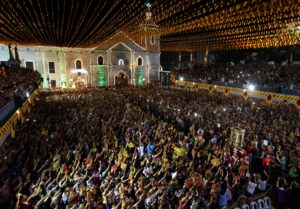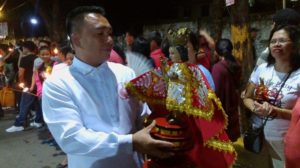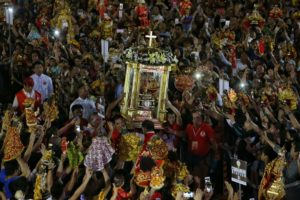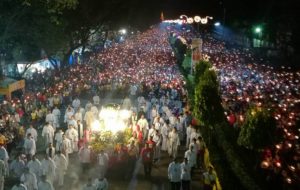
OVERFLOWING LOVE AND DEVOTION. Thousands of devotees wave their hands as the image of the Sto. Niño (rightmost portion) makes its way to the altar of the Pilgrim Center of the Basilica Minore del Sto. Niño. Police said some 80,000 devotees, twice higher than last year’s number, joined this year’s penitential Walk with Jesus, the opening salvo of the Feast of the Holy Child.
CDN PHOTO/JUNJIE MENDOZA
Record number of devotees join penitential Walk with Jesus
For 10 years, John Paul Abarquez’s life was a mess. He indulged in drugs and gangs and thought of it as fun.
“Nadala ko sa barkada (I was swayed by friends),” he said.
When he was 16, Abarquez, a resident of Barangay Cogon-Pardo in Cebu City, was stabbed in the back during a brawl with another fraternity and was bedridden at home for two months.
Throughout his ordeal, not one member of his gang came to visit him.
“Hasta ang akong mga ginikanan nibiya tungod sa kahadlok kay mora na ko og boang. (My parents also left me out of fear because I was like an insane person at that time),” Abarquez told Cebu Daily News.
Despondent, it was then when he realized his mistakes.
“Nawagtang man tuod ang tanan gikan nako apan ang Ginoo nagpabilin. Didto nako nasinati ang Iyang gugma. (Everyone left me, but not God. It was when I felt His love),” he said.

John Paul Abarquez holds an image of the Sto. Niño during the “Walk With Jesus” procession which marked the start of the 453rd Fiesta Señor celebration. /CDN PHOTO/ADOR MAYOL
When he got healed of his ailment, Abarquez waged a personal crusade to get rid of his addiction and to start anew.
Upon the invitation of a friend, he decided to become a lay minister at the Basilica Minore del Sto. Niño to thank God for giving him another chance at life.
“Diha sa kinabuhi sa pagpakasala, dili ko mahimutang. Daghan kog kahadlok. Apan sa dihang nagbag-o ko sa akong kinabuhi, nasinati nako ang tinuod nga kagawasan ug nawala ang akong mga kahadlok. (While living in sin, I was uneasy and had lots of fears. But when I decided to change my life, it was then when I experienced true freedom, and my fears vanished),” said Abarquez as tears welled up in his eyes.
Abarquez, who now works as a maintenance crew of a public hospital in Cebu City, credited the Sto. Niño for his renewal and for saving the life of his only daughter who almost died of dengue.
Abarquez, now 33, joined thousands of devotees during the annual penitential “Walk with Jesus” from Fuente Osmeña to the Basilica Minore del Sto. Niño in downtown Cebu City at 4 a.m. on Thursday.
Sacred walk
The two-kilometer prayer walk opens this year’s Fiesta Señor celebration in honor of the Child Jesus.
Devotees carried images of the Sto. Niño, prayed the Holy Rosary and sang liturgical hymns, which were broadcast live on radio and amplified by speakers.
There were no fireworks or balloons along the procession route following an appeal from the Augustinian priests in charge of the Basilica to maintain the solemnity of the event and for public safety.
Instead, a sea of candlelight illuminated the length of Osmeña Boulevard during the sacred walk shortly before daybreak.
Both Chief Supt. Jose Mario Espino, director of the Police Regional Office in Central Visayas, and the Cebu City Command and Control Center estimated the number of devotees who took part in the opening salvo and first novena Mass at 80,000 or twice the size of last year’s attendees.
Cebu City Councilor Dave Tumulak, deputy mayor on police matters, said they computed the crowd size with a density of four persons per square meter.
“The procession and first Mass were very peaceful. We thank everyone who secured the devotees,” he said in an interview.
At least 273 policemen were deployed from Fuente Osmeña rotunda down to the Basilica during the prayer walk.
The flower-decked carroza that carried the image of the Sto. Niño arrived at the Basilica at 5:19 a.m. and was welcomed with cheers of “Viva Pit Señor!” and “Viva Señor Sto. Niño” as the church bells pealed.
The 3,500-capacity church courtyard was packed with thousands more spilling into the streets.
They watched the Eucharistic celebration through large LED screens and television monitors installed around the church complex.

The glass case containing the image of the Sto. Niño arrives from the “Walk with Jesus” procession and is welcomed by a crowd of devotees at the Basilica Minore del Sto. Niño’s Pilgrim Center. (CDN PHOTO/JUNJIE MENDOZA).
Manifestation of faith
In his homily, Fr. Pacifico “Jun” Nohara Jr., the rector of the Basilica, said the prayer walk which marked the start of the Fiesta Señor was not a form of exercise to lose weight but a “sacrificial manifestation of our faith.”
“How blessed we are that the original image of the Sto. Niño — one of the oldest religious icons in the country — is here with us. God, through this image, hears our prayers, grants our heart’s desires, gives us hope, and inspires us to become better persons,” he said.
The image of the Sto. Niño was given as a baptismal gift by Portuguese explorer Ferdinand Magellan to Cebu’s Queen Juana in 1521. Two other images — the Ecce Homo and the Blessed Virgin Mary — were given to Rajah Humabon and the natives.
Nohara called on the people to live out their faith and to evangelize through words and deeds.
“No matter what we are in life, no matter what we were in the past, let us choose healing and the path of righteousness. Let us serve the Lord and participate in the mission of the church as new evangelizers,” he said.
Renewed disciples
This year’s celebration carries the theme “Sto. Niño: Inspiration of Renewed Disciples for the New Evangelization” which is patterned after the pastoral thrust of the Catholic Bishops’ Conference of the Philippines (CBCP) on the Year of the Clergy and Consecrated Persons.
In 2013, the CBCP launched a nine-year spiritual journey towards the 500th Jubilee of Christianization of the Philippines in 2021 with different themes for each year.
Nohara said being disciples of the Lord, however, is not an easy task.
“In our times, there are lots of obstacles such as secularism and even temptations to become selfish and to hate others. But let us remember that God is not pleased with those who hate his fellow human being. God does not favor the proud and unrepentant,” Nohara said.
As part of the tradition, the fiesta’s Hermano and Hermana Mayores for 2018 — Rosalina Go and son Mark — were officially presented to the people during the Mass with about 50 diocesan and religious priests as concelebrants.
Solemn rituals
During the offertory, people waved their hands in the air in unison as they sang “Bato-Balani sa Gugma” (Magnet of love), an ancient hymn in honor of the Sto. Niño.
At the end of the first novena Mass, Nohara carried the image of the Sto. Niño and led people in dancing the traditional one-step-forward, two-steps-backward Sinulog dance for about five minutes.
The Basilica complex, which has been the center of the four-century-old devotion to the Sto. Niño, will be opened 24 hours from January 11 to 21 to accommodate the multitude of Sto. Niño devotees who come to pay homage to the original image of the Sto. Niño, which is enthroned in a glass case at a side chapel inside the Basilica.
The church, however, will be closed from 9 p.m. to 11 p.m. to allow the janitors to clean the Basilica.
Except on January 11 and 19 when there are dawn processions, 11 Masses will be held at the Pilgrim Center every day leading to the feast of the Sto. Nino.

PHOTO by Christian Maningo
Traslacion
On Jan. 19, a Friday, another prayer walk from Fuente Osmeña to the Basilica will be held to be followed by the Misa de Traslacion at 5:30 a.m. The Sto. Niño and Our Lady of Guadalupe de Cebu images will then be brought to the National Shrine of St. Joseph in Mandaue City in a motorcade.
The annual “traslacion,” a Spanish word which means “to transfer or move,” depicts the “reunion” of the Holy Family — the Child Jesus, His mother Mary and foster father Joseph.
The images will stay overnight at the St. Joseph’s National Shrine. At 2 a.m. on Saturday, January 20, a send-off Mass will be celebrated at the National Shrine of St. Joseph. But unlike the previous years, there will be no more foot procession that will bring the images of the Sto. Niño and the Our Lady of Guadalupe to the Ouano Wharf before the fluvial procession.
Instead, the images will be transported in a motorcade to the Nuestra Señora de Regla National Shrine in Lapu-Lapu City for the 4 a.m. Mass, the first time in 37 years that the fluvial procession will start in Lapu-Lapu City.
The Augustinian fathers have decided to extend the annual traslacion from Mandaue City to the adjacent island of Mactan, particularly in Lapu-Lapu City, in response to numerous requests from Oponganons who want to be visited by the images during the festivities.
Fluvial and street processions
This year, the fluvial procession will start at the Naval Forces Central Wharf in Barangay Looc at 6 a.m. From there, a sea voyage across the Mactan Channel will bring the images of the Child Jesus and Mary to Pier 1 in Cebu City.
A foot procession from Pier 1 will bring the images back to the Basilica where the reenactment of the first Mass, baptism, and wedding will be held.
The Philippine Coast Guard-Cebu is accepting registration of participating vessels, but boat owners will need to register first with the Maritime Industry Authority (Marina).
At 1:30 p.m. of January 20, the grand solemn procession of the Sto. Niño will start, covering 5.8 kilometers, along the city’s main streets.
From the Basilica, the carrozas of St. Joseph, Our Lady of Consolation and the Sto. Niño de Cebu will pass along Osmeña Boulevard.
Upon reaching the Fuente Osmeña circle, the procession will proceed to General Maxilom Avenue, Imus Street, M.J. Cuenco Avenue, Urdaneta St., P. Burgos St., and back to the Basilica.
A Mass will be celebrated by Palo Archbishop John Du at 6 p.m. to be followed by an hour-long traditional religious Sinulog to the beat of the drums.
On Sunday, Jan. 21, the feast day of the Sto. Niño, Cebu Archbishop Jose Palma will officiate a pontifical Mass at 6 a.m. to be followed by eight other Masses.
Disclaimer: The comments uploaded on this site do not necessarily represent or reflect the views of management and owner of Cebudailynews. We reserve the right to exclude comments that we deem to be inconsistent with our editorial standards.
